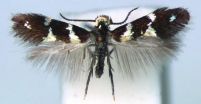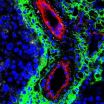(Press-News.org) LA JOLLA, Calif., February 23, 2012 – Researchers at Sanford-Burnham Medical Research Institute (Sanford-Burnham) and the Medical School of Hannover in Germany recently discovered how the botulinum neurotoxin, a potential bioterrorism agent, survives the hostile environment in the stomach on its journey through the human body. Their study, published February 24 in Science, reveals the first 3D structure of a neurotoxin together with its bodyguard, a protein made simultaneously in the same bacterium. The bodyguard keeps the toxin safe through the gut, then lets go as the toxin enters the bloodstream. This new information also reveals the toxin's weak spot—a point in the process that can be targeted with new therapeutics.
"Now that we better understand the structure of the bacterial machinery that was designed for highly efficient toxin protection and delivery, we can see more clearly how to break it," said Rongsheng Jin, Ph.D., assistant professor in Sanford-Burnham's Del E. Webb Neuroscience, Aging and Stem Cell Research Center and senior author of the study.
The Janus-faced toxin
The botulinum neurotoxin is two-faced. On one side, it's the most poisonous substance known to man, causing botulism. Accidental botulinum neurotoxin poisoning is usually food-borne, but it's also considered a potential bioterrorism agent. On the other side, botulinum neurotoxin is also used an effective therapy and popular cosmetic, such as in BOTOX.
The neurotoxin accomplishes both the good and the bad using the same trick—paralyzing muscle cells by disrupting their connections with the nerves that tell them how and when to move. But before the neurotoxin can gain access to muscles and the neurons that control them, it must make a remarkable journey through the body—surviving the digestive enzymes and extreme acidic environment in the stomach, penetrating the small intestine, and entering the bloodstream.
Sneaking a peek at the neurotoxin and its bodyguard
This latest study on the botulinum neurotoxin was the result of a close collaboration between the Jin group and a research group at the Institute of Toxicology at the Medical School of Hannover, led by Andreas Rummel, Ph.D., an expert on clostridial neurotoxins. They used a technique called X-ray crystallography, which uses powerful X-ray beams to produce 3D images of proteins at the atomic level, to study a genetically inactivated, nontoxic version of the botulinum neurotoxin.
These experiments helped the team visualize the atomic structure of all three parts of the toxin: 1) the region that recognizes neurons, 2) the enzyme that acts like a pair of scissors to cut human neural proteins and cause paralysis, and 3) the needle that punches holes to help deliver the enzyme to the nerve terminal. What's more, the researchers also captured the toxin's interaction with a second bacterial protein, called nontoxic nonhemagglutinin (NTNHA).
"We were surprised to see that NTNHA, which is not toxic, turned out to be remarkably similar to botulinum neurotoxin. It's composed of three parts, just like a copy of the toxin itself. These two proteins hug each other and interlock with what looks like a handshake," said Jin.
VIDEO:
This video shows the interlocked structure of the botulinum neurotoxin and its bodyguard, NTNHA.
Click here for more information.
As the toxin moves through the body, NTNHA acts as its bodyguard, keeping it from being degraded when times are tough in the acidic stomach. However, as this study revealed, the toxin has a weak spot: when the toxin/NTNHA complex punches its way out of the small intestine, it's the change in pH that triggers a conformational change, breaks up the duo, and releases only the unprotected toxin into the bloodstream.
Towards prevention and therapy
According to Jin, this new knowledge about how the botulinum neurotoxin and NTNHA balance the need for strong binding and a timely release could be exploited to outsmart them.
"We now hope we might be able to fool the toxin and its bodyguard using a small molecule that sends the wrong signal—mimicking pH change, prematurely breaking up their protective embrace, and leaving the stomach's digestive enzymes and acid to do their job," he said. "We envision this type of therapy—either alone or in combination with other therapies currently in development—could be given preventively at a time when botulinum neurotoxin contamination becomes a public health concern."
Moreover, this type of therapy could be designed for oral delivery, rather than injection, making it easier to treat large numbers of people during an outbreak. A similar strategy could be used to deliver other protein-based drugs that usually need to be injected. "Here, protein drugs could be linked to a botulinum neurotoxin fragment and protected with NTNHA. Then we could possibly take them by mouth," Jin said.
INFORMATION:
This research was partly funded by a start-up fund from Sanford-Burnham, the Alfred P. Sloan Foundation, the German Research Foundation, the Robert-Koch-Institute, the National Institute of Allergy and Infectious Diseases, the U.S. Department of Energy, and the U.S. Department of Health and Human Services. The study's co-authors include Shenyan Gu, Sanford-Burnham; Sophie Rumpel, Medical School of Hannover; Jie Zhou, Sanford-Burnham; Jasmin Strotmeier, Medical School of Hannover; Hans Bigalke, Medical School of Hannover; Kay Perry, Cornell University and Argonne National Laboratory; Charles B. Shoemaker, Tufts Cummings School of Veterinary Medicine; Andreas Rummel, Medical School of Hannover; and Rongsheng Jin, Sanford-Burnham.
About Sanford-Burnham Medical Research Institute
Sanford-Burnham Medical Research Institute is dedicated to discovering the fundamental molecular causes of disease and devising the innovative therapies of tomorrow. The Institute consistently ranks among the top five organizations worldwide for its scientific impact in the fields of biology and biochemistry (defined by citations per publication) and currently ranks third in the nation in NIH funding among all laboratory-based research institutes. Sanford-Burnham is a highly innovative organization, currently ranking second nationally among all organizations in capital efficiency of generating patents, defined by the number of patents issued per grant dollars awarded, according to government statistics.
Sanford-Burnham utilizes a unique, collaborative approach to medical research and has established major research programs in cancer, neurodegeneration, diabetes, and infectious, inflammatory, and childhood diseases. The Institute is especially known for its world-class capabilities in stem cell research and drug discovery technologies. Sanford-Burnham is a U.S.-based, non-profit public benefit corporation, with operations in San Diego (La Jolla), Santa Barbara, and Orlando (Lake Nona). For more information, please visit our website or blog. You can also receive updates by following us on Facebook and Twitter.
Disarming the botulinum neurotoxin
Sanford-Burnham researchers determine the first 3-D structure of the botulinum neurotoxin, together with the protein bodyguard that guides it through the body -- revealing weak spots that could be exploited to develop new counterterrorism measures
2012-02-24
ELSE PRESS RELEASES FROM THIS DATE:
Plastic Surgeon Comments on Tummy Tuck Advancements
2012-02-24
It's 2012, which for the plastic surgery industry means more advancements than ever before.
While groundbreaking technology and the emergence of new surgical techniques are exciting, potential patients should be sure that these innovations are time-tested before seriously considering them. A tummy tuck surgeon in Birmingham, Dr. Michael Beckenstein, stresses that patients should choose a surgeon based on the doctor's qualifications and experience with a particular procedure, and not just because he or she offers the "latest and greatest" treatments.
"As ...
Study: Evolution of earliest horses driven by climate change
2012-02-24
When Sifrhippus, the earliest known horse, first appeared in the forests of North America more than 50 million years ago, it would not have been mistaken for a Clydesdale. It weighed in at around 12 pounds -- and it was destined to get much smaller over the ensuing millennia.
Sifrhippus lived during the Paleocene-Eocene Thermal Maximum, a 175,000-year interval of time some 56 million years ago in which average global temperatures rose by about 10 degrees Fahrenheit, caused by the release of vast amounts of carbon into the atmosphere and oceans.
About a third of mammal ...
Genetic risk for elevated arsenic toxicity discovered
2012-02-24
One of the first large-scale genomic studies conducted in a developing country has discovered genetic variants that elevate the risk for skin lesions in people chronically exposed to arsenic. Genetic changes found near the enzyme for metabolizing the chemical into a less toxic form can significantly increase an individual's risk for developing arsenic-related disease.
The discovery could point the way to new screening and intervention options for people who are exposed to groundwater with high levels of arsenic, said scientists at the University of Chicago Medicine, Columbia ...
Italian vineyards invaded from North America by new species of leafminer
2012-02-24
Since in 2006 an unknown leafmining moth was found in North Italian vineyards by Mario Baldessari and colleagues, often in great numbers, scientists have tried to put a name to this apparently new invader. Italian scientists from the Fondazione Edmund Mach di San Michele all'Adige and the Università di Padova turned for help to taxonomists in the Netherlands and United States. The new species was described in the open access journal ZooKeys.
The family to which the moth belongs, the shield bearing leafminers (Heliozelidae) appeared to be poorly studied in North America, ...
Global Gaming Events Launches $5,000 Slots Freeroll with Casino Titan Open to All Depositing Players Including USA
2012-02-24
Global Gaming Events launches another whopping $5,000 casino freeroll tournament with Casino Titan to be held in March 2012.
This event runs on Saturday, March 3rd, 2012 3pm ET to Sunday, March 4th, 2012 3pm ET. All players who have made at least one deposit or reload of a minimum of $50 during the month of February 2012 are eligible to play. Players must also pre-register for the event with Global Gaming Events to be eligible.
The tournament formats will be a 10 minute 5,000 Starting Chip Slot Tournaments and will have a maximum of 1000 players. Each player will ...
Breaking down cancer's defense for future vaccines
2012-02-24
Researchers at the EPFL have identified an important mechanism that could lead to the design of more effective cancer vaccines. Their discovery of a new-found role of the lymphatic system in tumour growth shows how tumours evade detection by using a patient's own immune system.
Tumour cells present antigens or protein markers on their surfaces which make them identifiable to the host immune system. In the last decade, cancer vaccines have been designed that work by exposing the patient's immune cells to tumour-associated antigens and so priming them to kill cells that ...
Sani Beach Club Services Upgraded and Improved for 2012
2012-02-24
Sani Beach Club is situated on its own stretch of private beach within Sani Resort on the beautiful Kassandra peninsula in Halkidiki, Northern Greece.
New Dining Options
There are three exceptional restaurants at Sani Beach Club - Dunes, Olympos and Ouzerie, each has redesigned its menu to offer guests a more traditional Greek gourmet experience. The new menu at Ouzerie has an innovative new twist that is similar to Sani Resort's famous new-age Greek restaurant Tomata. There will be a new Greek themed breakfast menu offering guests traditional morning specialities ...
Farm 'weeds' have crucial role in sustainable agriculture
2012-02-24
Plants often regarded as common weeds such as thistles, buttercups and clover could be critical in safe guarding fragile food webs on UK farms according to Researchers funded by the Biotechnology and Biological Sciences Research Council (BBSRC).
Published tomorrow in Science, researchers from the University of Bristol detail the interactions that occur between the different food webs commonly found on farms throughout the UK and the robustness of these interactions to species loss. In one of the first studies to look simultaneously at multiple types of food webs, the researchers ...
Earliest horses show past global warming affected body size of mammals
2012-02-24
GAINESVILLE, Fla. --- As scientists continue developing climate change projection models, paleontologists studying an extreme short-term global warming event have discovered direct evidence about how mammals respond to rising temperatures.
In a study appearing in Science Feb. 24, researchers from eight institutions led by scientists from the University of Florida and University of Nebraska found a correlation between temperature and body size in mammals by following the evolution of the earliest horses about 56 million years ago: As temperatures increased, their body ...
Study examines number of GP visits before cancer patients are referred to specialists
2012-02-24
More than three quarters (77%) of cancer patients who first present to their family doctors (GPs) with suspicious symptoms are referred to hospital after only one or two consultations, a new study has found. However, the new research also shows a wide variation in the number of times a cancer patient sees their general practitioner before they are referred to a specialist, with the most pre-referral consultations occurring when the cancer was one of the less common types, or when the patient was either female, young, or an older person from an ethnic minority. The research ...
LAST 30 PRESS RELEASES:
NTIDE: Disability employment holds steady after data hiatus
Social lives of viruses affect antiviral resistance
Dose of psilocybin, dash of rabies point to treatment for depression
Helping health care providers navigate social, political, and legal barriers to patient care
Barrow Neurological Institute, University of Calgary study urges “major change” to migraine treatment in Emergency Departments
Using smartphones to improve disaster search and rescue
Robust new photocatalyst paves the way for cleaner hydrogen peroxide production and greener chemical manufacturing
Ultrafast material captures toxic PFAS at record speed and capacity
Plant phenolic acids supercharge old antibiotics against multidrug resistant E. coli
UNC-Chapel Hill study shows AI can dramatically speed up digitizing natural history collections
OYE Therapeutics closes $5M convertible note round, advancing toward clinical development
Membrane ‘neighborhood’ helps transporter protein regulate cell signaling
Naval aviator turned NPS doctoral student earns national recognition for applied quantum research
Astronomers watch stars explode in real time through new images
Carbon-negative building material developed at Worcester Polytechnic Institute published in matter
Free radicals caught in the act with slow spectroscopy
New research highlights Syntax Bio’s platform for simple yet powerful programming of human stem cells
Researchers from the HSE University investigated reading in adolescents
Penn Nursing study: Virtual nursing programs in hospitals fall short of expectations
Although public overwhelmingly supports hepatitis B vaccine for a newborn, partisan differences exist
DFW backs UTA research to bolster flood resilience
AI brain scan model identifies stroke, brain tumors and aneurysms – helping radiologists triage and speed up diagnoses
U.S. News & World Report gives Hebrew Rehabilitation Center highest rating
Optica and DPG name Antoine Browaeys 2026 Herbert Walther Award recipient
The presence of a gun in the home increases the risk of suicide by three to five times
PFAS exposure and endocrine disruption among women
Vaccines and the 2024 US presidential election
New approach narrows uncertainty in future warming and remaining carbon budget for 2 °C
When pregnancy emergencies collide with state abortion bans
American College of Cardiology supports front of package nutrition labeling
[Press-News.org] Disarming the botulinum neurotoxinSanford-Burnham researchers determine the first 3-D structure of the botulinum neurotoxin, together with the protein bodyguard that guides it through the body -- revealing weak spots that could be exploited to develop new counterterrorism measures





